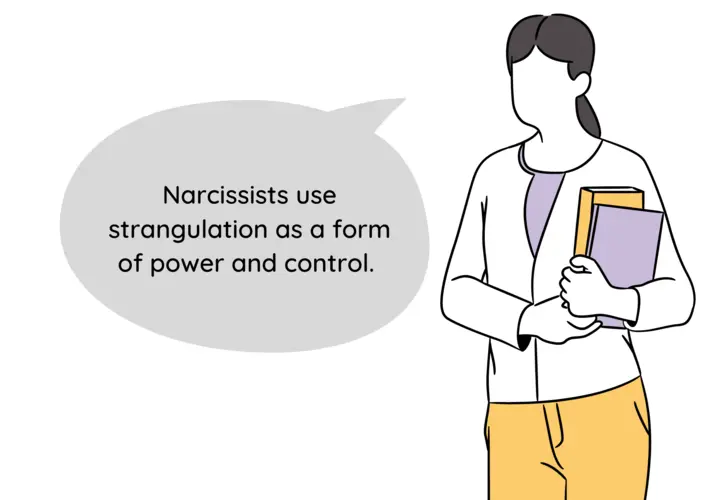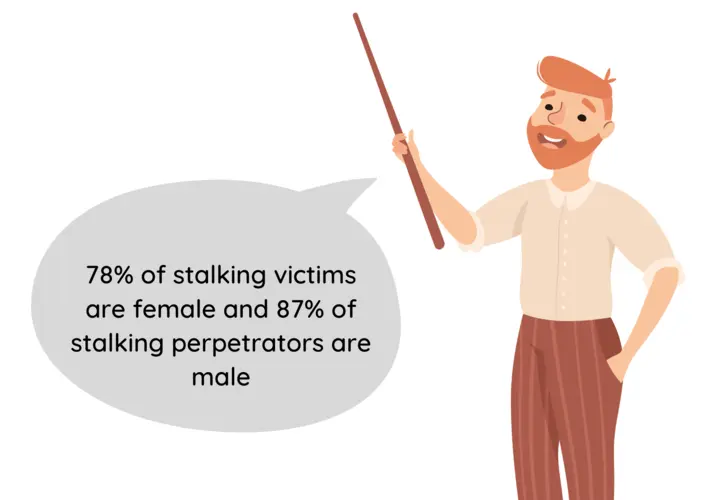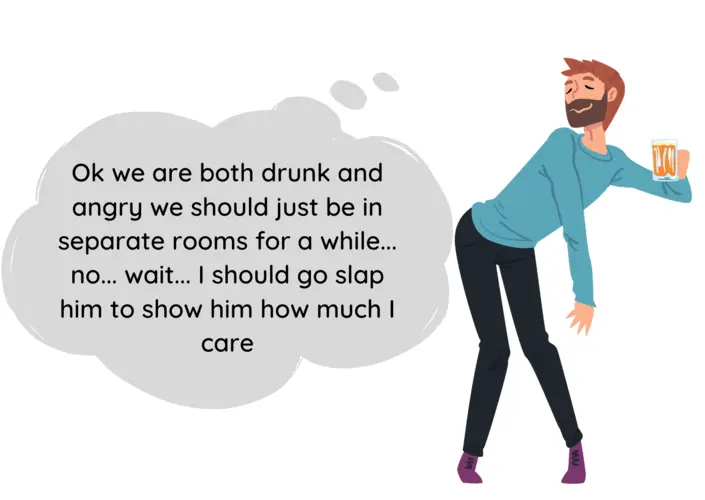It is no secret that narcissists can be unpredictable and dangerous. They have been known to subject the people in their surrounding environment to unfathomable levels of both physical and psychological abuse.
Narcissists are most dangerous when they strangle you, when they stalk you, when they are sexually violent, when they have access to weapons, when they are under the influence of alcohol, or when they have a substance use disorder.
In this article we are going to guide you through the reason why narcissists are most dangerous under these circumstances. We have also invited Karina Ramdath, a Registered Social Worker and Therapist, to speak about creating reliable safety plans in a short video (see below).
Karina Ramdath, a Registered Social Worker and Therapist, Speaks About Creating a Safety Plan
For the best experience, please rotate your mobile device sideways.
1. When They Are Willing to Strangle You
Strangulation refers to when pressure is applied from the outside, cutting off airflow and/or blood vessels in the neck, preventing oxygen from reaching the brain.
It is very common for those being strangled by a narcissist to lose consciousness due to the blocking of the blood flow to and from the brain.
Narcissists use strangulation as a form of power and control.

It is a very serious form of abuse because strangulation can lead to a loss of consciousness within five to ten seconds and cause death within a few minutes.
Strangulation is recognized as one of the most lethal forms of violence.1
In fact, because there’s such a thin line between unconsciousness and death, strangulation sits just before homicide on the continuum of domestic violence risk assessment.
2. When They are Stalking You
Stalking means engaging in a course of conduct directed at a specific person that would cause a reasonable person to fear for his or her safety or the safety of others or suffer substantial emotional distress.2
Now, stalking is a gender-neutral crime. However, 78% of stalking victims are female and 87% of stalking perpetrators are male.6

76% of women murdered by an intimate partner were stalked first; 85% of women who survived murder attempts were stalked.3
89% of femicide victims who had been physically assaulted before their murder were also stalked in the last year prior to their murder.4
54% of femicide victims reported stalking to the police before they were killed by their stalkers.5

81% of women who were stalked by a current or former husband or cohabitating partner were also physically assaulted by that partner; 31% of women were sexually assaulted.6
20% of male stalking victims seek psychological counseling as a result of their victimization.7
Stalking is a huge red flag for both men and women. It is believed that 1 in 4 stalking victims contemplate suicide.8
3. When They Are Sexually Violent
The term sexual violence refers to crimes like sexual assault, rape, and sexual abuse. Sexual violence is more about power than it is about sex.
Meaning that the motivation that an abuser has to be sexually violent stems from their need for dominance and control.
Similar to stalking, sexual violence is a gender-neutral crime. But it is much more likely to involve a female victim and male perpetrator.

In fact, 82% of all juvenile victims are female and 90% of adult rape victims are female.9 While 1 out of every 10 rape victims are male.10
Women who experience sexual assault in addition to physical violence are at a higher risk for homicide than women who are physically abused but not raped.11
Sexual homicide (SH) is the most severe outcome of sexual violence. It is among the most violent, feared, and well publicized forms of murder.
4. When They Have Access to Weapons
Over half of all intimate partner homicides are committed with guns.
In fact, victims of domestic violence are five times more likely to be killed when their abuser has access to a firearm.12
Research shows that there is a very strong connection between aggression of any kind and narcissism. In fact, narcissism is related to a 21% increase in aggression and an 18% increase in violence.13

The work of Kjærvik and Bushman14 revealed that provocation was the key link between narcissism and aggression. That said, narcissists don’t always have to be provoked to become aggressive.
They found that individuals with high levels of narcissism were aggressive when they felt threatened or provoked in some way (i.e. ignored, insulted, held accountable, etc.).
The feelings of superiority, entitlement, specialness, and uniqueness that narcissists have can cause them to attack others in an aggressive manner.
Sometimes this aggression can be violent (i.e. actually intending to cause extreme physical harm, such as injury or death).

It is for this reason that narcissists are most dangerous when they have access to weapons.
5. When They Use Alcohol
Interestingly enough, alcohol consumption is more closely associated with violence than any other substance. Severe alcohol intoxication by the abuser, victim, or both, plays a role in almost half of all violent crimes15.
With that being said, intoxication is not the root cause of violence. It only increases an abuser’s likelihood of displaying violent behavior. Researchers have come up with a few different theories for this (see below)
The first theory is the disinhibition hypothesis16.
This suggests that because alcohol disrupts the normal brain functions and weakens the areas that control impulses and urges, the consumption of alcohol encourages people to engage in behaviors, such as aggression, that they would normally suppress.

The second theory is alcohol myopia17.
This suggests that when an individual is intoxicated, it narrows their focus. For some, this narrowed focus can lead to misperceptions of certain situations.
For example, an innocent joke at a party could be perceived as an act of hostility by the intoxicated individual.
The third theory is cognitive function impairment18.
This theory suggests that intoxication corrupts how individuals respond to a situation because alcohol interrupts cognitive processing, making it difficult to problem-solve, control anger, and make good decisions.

The fourth theory is the consideration of future consequences19.
Simply put, those who often ignore future consequences and focus on the here-and-now are more aggressive when intoxicated.
6. When They Have a Substance Use Disorder
A substance use disorder (SUD) is a mental disorder that affects a person’s brain and behavior, leading to a person’s inability to control their use of substances such as legal or illegal drugs, alcohol, or medications.
Research shows that between 25% and 50% of men who commit acts of domestic violence suffer from SUDs and 80% of child abuse cases involved the use of drugs and alcohol20.

- Opioid Use Disorder
- Marijuana Use Disorder
- Nicotine Use Disorder
- Stimulant Use Disorder
- Sedative Use Disorder
- Hallucinogen Use Disorder
- Alcohol Use Disorder
What Should You Take Away From This Article?
Narcissists are most dangerous when they strangle you, when they stalk you, when they are sexually violent, when they have access to weapons, when they are under the influence of alcohol, or when they have a substance use disorder.
Suggested Reading:
Our articles “How to Know if a Narcissist Will Kill You (16 Signs to Keep You Safe)” and “Will a Narcissist Try to Get Revenge?“ have a lot of helpful information that you can use to stay as safe as possible around a narcissist.
About the Author

Hey, I’m Elijah.
I experienced narcissistic abuse for three years.
I create these articles to help you understand and validate your experiences.
Thank you for reading, and remember, healing is possible even when it feels impossible.
References:
[1] The Law and You: Strangulation always serious
[2] STALKING
[3] McFarlane, Judith M., et al. “Stalking and intimate partner femicide.” Homicide studies 3.4 (1999): 300-316.
[4] Ibid.
[5] Ibid.
[6] Tjaden, Patricia Godeke, and Nancy Thoennes. Stalking in America: Findings from the national violence against women survey. US Department of Justice, Office of Justice Programs, National Institute of Justice, 1998
[7] Ibid.
[8] Pathe, Michele, and Paul E. Mullen. “The impact of stalkers on their victims.” The British Journal of Psychiatry 170.1 (1997): 12-17.
[9] Rothbaum, Barbara Olasov, et al. “A prospective examination of post‐traumatic stress disorder in rape victims.” Journal of Traumatic stress 5.3 (1992): 455-475.
[10] Berzofsky, Marcus, et al. “Female victims of sexual violence, 1994–2010.” Bureau of Justice Statistics (2013).
[11] Messing, Jill Theresa, et al. “The Arizona intimate partner homicide (AzIPH) study: A step toward updating and expanding risk factors for intimate partner homicide.” Journal of family violence 36.5 (2021): 563-572.
[12] J.C. Campbell, et al., “Risk Factors for Femicide in Abusive Relationships: Results from a Multisite Case Control Study,” American Journal of Public Health 93, no.7 (2003): 1089–1097.
[13] Kjærvik, Sophie L., and Brad J. Bushman. “The link between narcissism and aggression: A meta-analytic review.” Psychological Bulletin 147.5 (2021): 477.
[14] Ibid.
[15] Ärzteblatt, D. Ä. G., Redaktion Deutsches. Alcohol-Related Aggression (18.10.2013). Deutsches Ärzteblatt.
[16] Topper, Stephen M., Aguilar, Viktoria Y., Elbel, Erin, and Pierce-Shimomura, Jonathan T. (2014). Alcohol Disinhibition of Behaviors in elegans. Plos One.
[17] Steele, Claude M., and Robert A. Josephs. “Alcohol myopia: Its prized and dangerous effects.” American psychologist 45.8 (1990): 921.
[18] Fillmore, Mark Τ. “Acute alcohol-induced impairment of cognitive functions: Past and present findings.” International Journal on Disability and Human Development 6.2 (2007): 115-126.
[19] Bushman, Brad J., Ph.D., Giancola, Peter R., Ph.D., Parrott, Dominic J., Ph.D., and Roth, Robert M., Ph.D. (2012). Failure to Consider Future Consequences Increases the Effects of Alcohol on Aggression. Journal of Experimental Social Psychology, 48(2), 591-595.
[20] Substance Abuse and Mental Health Services Administration. Treatment Improvement Protocol (TIP 25). Substance Abuse Treatment and Domestic Violence.
